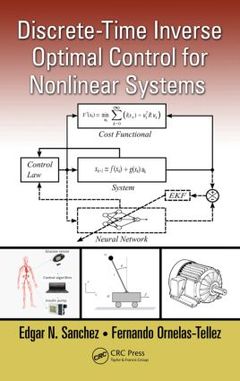Description
Discrete-Time Inverse Optimal Control for Nonlinear Systems
System of Systems Engineering Series
Authors: Sanchez Edgar N., Ornelas-Tellez Fernando
Language: English
Subject for Discrete-Time Inverse Optimal Control for Nonlinear Systems:
Keywords
Inverse Optimal Control; discrete-time inverse optimal control; Inverse Optimal Control Law; nonlinear systems; Discrete Time Inverse Optimal Control; passivity theory; Discrete Time Nonlinear System; control Lyapunov function; Trajectory Tracking; stabilization; Achieve Trajectory Tracking; robust stabilization; ISS Lyapunov Function; robust controllers; HJB Equation; Inverse Optimal Control Scheme; neural networks; Uncertain Discrete Time Nonlinear System; type 1 diabetes mellitus control; ISS Property; glycemic control of type 1 diabetes; Positive Systems; Fernando Ornelas-Tellez; T1 Dm; Globally Asymptotically Stabilized; Positive Definite Function; CLF; Uncertain Nonlinear Systems; Disturbed System; Lyapunov Function; Optimal Control Law; T1 Dm Patient; Linear Positive Systems; Neural Network Identifier; Boost Converter; Synchronous Generator
Approximative price 232.80 €
In Print (Delivery period: 15 days).
Add to cartPublication date: 04-2013
· 15.6x23.4 cm · Hardback
Approximative price 129.58 €
In Print (Delivery period: 14 days).
Add to cartPublication date: 04-2017
· 15.6x23.4 cm · Paperback
Description
/li>Contents
/li>Readership
/li>Biography
/li>
Discrete-Time Inverse Optimal Control for Nonlinear Systems proposes a novel inverse optimal control scheme for stabilization and trajectory tracking of discrete-time nonlinear systems. This avoids the need to solve the associated Hamilton-Jacobi-Bellman equation and minimizes a cost functional, resulting in a more efficient controller.
Design More Efficient Controllers for Stabilization and Trajectory Tracking of Discrete-Time Nonlinear Systems
The book presents two approaches for controller synthesis: the first based on passivity theory and the second on a control Lyapunov function (CLF). The synthesized discrete-time optimal controller can be directly implemented in real-time systems. The book also proposes the use of recurrent neural networks to model discrete-time nonlinear systems. Combined with the inverse optimal control approach, such models constitute a powerful tool to deal with uncertainties such as unmodeled dynamics and disturbances.
Learn from Simulations and an In-Depth Case Study
The authors include a variety of simulations to illustrate the effectiveness of the synthesized controllers for stabilization and trajectory tracking of discrete-time nonlinear systems. An in-depth case study applies the control schemes to glycemic control in patients with type 1 diabetes mellitus, to calculate the adequate insulin delivery rate required to prevent hyperglycemia and hypoglycemia levels.
The discrete-time optimal and robust control techniques proposed can be used in a range of industrial applications, from aerospace and energy to biomedical and electromechanical systems. Highlighting optimal and efficient control algorithms, this is a valuable resource for researchers, engineers, and students working in nonlinear system control.
Introduction. Mathematical Preliminaries. Inverse Optimal Control: A Passivity Approach. Inverse Optimal Control: A Control Lyapunov Function Approach, Part I. Inverse Optimal Control: A Control Lyapunov Function Approach, Part II. Neural Inverse Optimal Control. Glycemic Control of Type 1 Diabetes Mellitus Patients. Conclusions. References.
Edgar N. Sanchez is a researcher at CINVESTAV-IPN, Guadalajara Campus, Mexico. He was granted a U.S. National Research Council Award as a research associate at NASA Langley Research Center (January 1985-March 1987). He is also a member of the Mexican National Research System (promoted to the highest rank, III, in 2005), the Mexican Academy of Science, and the Mexican Academy of Engineering. He has published more than 100 technical papers in international journals and conferences, and has served as reviewer for various international journals and conferences. His research interest centers on neural networks and fuzzy logic as applied to automatic control systems.
Fernando Ornelas-Tellez is currently a professor of electrical engineering at Michoacan University of Saint Nicholas of Hidalgo, Mexico. His research interests center on neural control, direct and inverse optimal control, passivity and their applications to biomedical systems, electrical machines, power electronics, and robotics.




